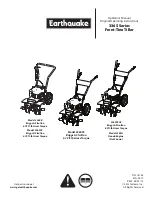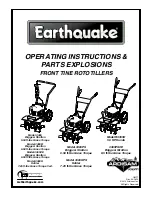
OPERATION
DANGER
For safe operation, the tine drive must disengage immediately when clutch
lever is released. If it does not, adjust belt and cable tension as described in
“ADJUSTMENT” section of this manual.
Never leave the tiller unattended with the engine running because children
might be attracted to a running tiller and could be injured if struck by the rotat-
ing tines.
OPERATION OF CHAIN DRIVE TILLER
1. When ground is hard (especially during spring and fall
plowing), place wheels in up position by removing the clevis
pin from the wheel clevis, and repositioning the wheel
frame bar. Replace the clevis pin and the pin clip (Figure
6). For weeding or cultivating, wheels may be left down if
you prefer.
2. Adjust the drag stake for comfortable operation. This
is done by removing the pin clip from the drag stake clevis
pin, removing the clevis pin, and sliding the drag stake up
or down. The drag stake should be set so that when it is
firmly in the ground, and your hands are on the tiller handle,
your arms hang comfortably with the elbows slightly bent.
3. Move the throttle control to center position. Start the en-
gine and allow it to warm up, then set the throttle at about
half speed. After you have become familiar with the tiller,
you may want to run the engine a little faster.
4. Press down firmly on the handles, and then squeeze the
clutch lever. The tines will begin to turn, but the tiller should
not move forward. If it does, don’t pull backwards -- merely
press down harder on the handles. When you find the right
amount of downward pressure so that the tines are digging
and the tiller is not moving forward, release the pressure
slightly. As you release it you’ll notice the tiller beginning to
move forward.
OPERATING TIPS
To acquire the knack of letting the tiller do the work without
effort on the part of the operator, we offer the following sug-
gestions:
1. Adjust drag stake so the handles are at such a height
that your arms hang straight down to contact them. Rear
wheels should be in up position for deep tillage or ease of
turning in confined areas.
2. Operate the tiller at about three fourths (3/4) throttle.
3. Don’t hurry the job -- proceed at a slow walk -- give the
IMPORTANT!
KEEP HANDS CLEAR OF BELT AND
TINES WHILE ENGINE IS RUNNING.
Figure 6
machine time to do its job.
4. Concentrate on keeping your arms relaxed (There is a
natural tendency for any beginner to tense up.). Operating
the tiller actually takes very little effort. Let the tiller do the
work.
5. When tilling on sloping ground, turn the front of the
machine uphill to sufficiently counteract the tendency to run
downhill.
6. For best results, operate at reduced throttle settings
when ground is extremely hard or rough.
7. When cultivating, raise drag stake until the handles are
the proper height as described in Item 1 or set rear wheels
in position. Proceed at a slow walk, watching the rotor as it
tills along the row.
8.
Tighten all nuts and bolts periodically.
TILLING PATTERN
Whenever possible till the soil in the direction in which the
planting or rows will run. If the soil is extremely hard and
dry, it may be advisable to till across the plot on the first
digging and then obtain the depth you want by tilling in the
direction the planting will be done.
TRANSPORT
To transport tiller from garden to storage area, lift the
handles until the drag stake is above ground level, set
the engine throttle at slow speed and walk the tiller on the
tines.
6
Summary of Contents for M30B
Page 8: ...8 Tiller Assembly Illustration 1...
Page 11: ...11...






























